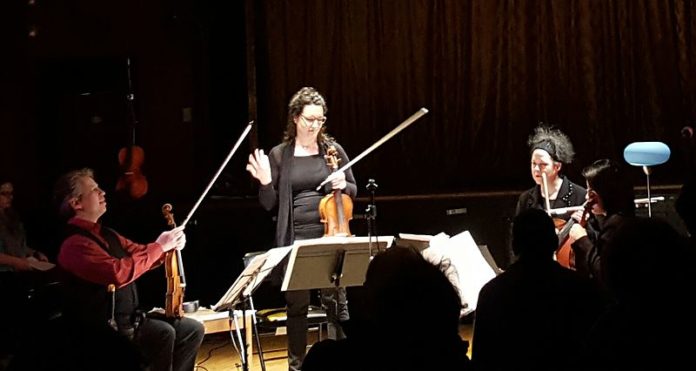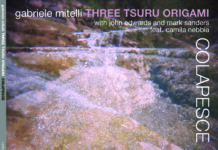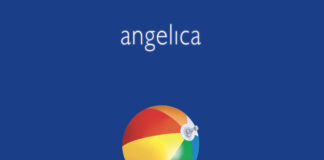 Over the course of its three centuries’ long existence, the string quartet has shown itself to be a highly resilient medium well-adaptable to changing developments in music. Traditionally weighted toward the contrapuntal, the string quartet in contemporary hands is equally effective in presenting texturally- or timbrally-oriented work, as shown in fine recent recordings of compositions by Scott Wollschleger, Lewis Nielson and Richard Karpen, among many others. But it also serves as an apt vehicle for composers concerned with questions of alternative architectures and pre-compositional structures. With Trip, their latest recording, Montréal’s Quatuor Bozzini present this latter side of the string quartet and its derivatives at the present moment.
Over the course of its three centuries’ long existence, the string quartet has shown itself to be a highly resilient medium well-adaptable to changing developments in music. Traditionally weighted toward the contrapuntal, the string quartet in contemporary hands is equally effective in presenting texturally- or timbrally-oriented work, as shown in fine recent recordings of compositions by Scott Wollschleger, Lewis Nielson and Richard Karpen, among many others. But it also serves as an apt vehicle for composers concerned with questions of alternative architectures and pre-compositional structures. With Trip, their latest recording, Montréal’s Quatuor Bozzini present this latter side of the string quartet and its derivatives at the present moment.Founded a few years before the turn of the century by sisters Isabelle and Stéphanie Bozzini, cellist and violinist respectively, the Quatuor Bozzini—originally called the Quatuor Euterpe—began with a focus on the traditional string quartet repertoire. Violinist Clemens Merkel joined the ensemble in 1999 and has been with it ever since; the remaining violin chair has been filled at various times by Geneviève Beaudry, Nadia Francaville, Erik Carlson, Mira Benjamin, and most recently, Alissa Cheung. Along with changes in personnel, the quartet’s artistic direction shifted to modern and contemporary music.
Trip is a collection of work for string quartet, sextet, and solo cello and violin by Canadian composer Christopher Butterfield (b. 1952). Butterfield, who is director of the University of Victoria School of Music, comes from a musical family, his brothers Paul and Benjamin both being classical tenors, the former a conductor as well. His own artistic background is eclectic though reflective of the times in which he grew up—when young he was a chorister for the King’s College Choir in the UK, and later was a performance artist and a rock guitarist. He has expressed an interest in treating composition as a kind of “puzzle” whose realized form derives from the operation of rules or analogous pre-compositional structures; several of the pieces on Trip fit that description. Much of his work has been created for chamber ensembles, dance and multimedia environments and, with the late librettist John Bentley Mays, includes Zurich 1916, an opera premised on the chance meeting, in Zurich’s Cabaret Voltaire, of Dadaists Hugo Ball and Emmy Hennings and exiled Russian revolutionary V.N. Lenin.
One of the works included in Trip, in fact, draws on music taken from Zurich 1916’s chorale. This is Lullaby, a string sextet composed in 1991. Butterfield sets the lullaby—a simple melody gently rocking back and forth—within a frame of drones, glistening harmonics and silences. In the closing section, the piece turns to a repeated and strangely vertiginous ascending motif made all the more affecting by the performers’ restrained urgency. The quartet, supplemented by violist Jennifer Theissen and the fine Baroque/early music cellist Elinor Frey, bring out an understated but real richness in the piece.
The quartet fall(2013), written for the Quatuor Bozzini, is a work both aleatory and serial. The pitch material consists of the four-note row AABA which Butterfield then subjected to chromatic rotations and randomly-generated dynamics. For most of its length the piece floats on long tones overlapping into dissonant chords; the emergent minor-second harmonies, made even more astringent by the quartet’s eschewing of vibrato, in places recall John Cage’s 1950 string quartet, which Quatuor Bozzini in fact recently recorded. Another aleatory piece, 1999’s Clinamen for solo violin, is a composition made up of 80 cards, each of which containing a brief phrase, to be played in the performer’s order of preference. As realized here by Merkel, the piece is an essay in unpredictability and immersion in the moment, in that no single event foreshadows anything that follows, and no subsequent event explains any that preceded it. Nor does any need to. Instead, there is a concatenation of short, independent and non-accumulating events separated by silences and differing from each other in pitch, phrasing, mood and tempo.
The recording’s title track, a quartet composed in 2008 for the ensemble, is an asymmetrical work of three short movements followed by a much longer closing movement. The piece opens with a polyphonic flourish playing out against a background wash of talk radio, followed by a driving, rhythmically dense second movement and a third movement that breaks the individual voices out into arco and pizzicato lines. The final movement is a reflective adagio of long, suspenseful harmonies sporadically scuffed by rough timbres.







